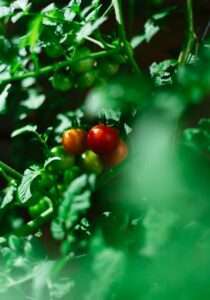
Horticulture News
By: Scott Eckert, Harvey County Extension Agent, Horticulture
During April in Kansas, you always have to have one eye on the weather forecast when it comes to planting tomatoes. The frost will get them if you plant them too soon! I don’t plant my tomatoes until May for exactly this reason.
Tomatoes are sensitive to frost and will not thrive in cold garden soils. In extreme southeastern Kansas, tomatoes can be transplanted in early to mid April. Late April to May is the suggested transplanting date for most of eastern and central Kansas. If there is a danger of frost after plants are set, be prepared to provide temporary cover.
Plant tomatoes where they will receive full sun for a half day or more. Plants grown in shade will be spindly and unproductive.
Tomatoes will grow in many different soil types, but they prefer a deep, loamy soil with a pH of 6.2 to 6.8. If topsoil is shallow, improve the growing area by mixing in a 2- to 3-inch layer of peat moss or compost to a depth of at least 6 inches. Otherwise, till the soil thoroughly with a spade or rototiller.
It is always a good idea to test your soil first but if you choose not to do a soil test, add 1 to 2 pounds of complete garden fertilizer per 100 square feet. Avoid fertilizers with too much nitrogen. Excessive nitrogen fertilization leads to spindly plants and few fruits. Fertilizers with 5-10-10, 6-12-12, 5-10-5 ratios, or about half as much nitrogen as phosphate, are the most desirable. If you know your phosphorus and potassium are already at a high level, just use a fertilizer with nitrogen only.
Spacing depends on plant size and whether plants will be staked. Small-vined types should be spaced 15 to 18 inches apart, and staked vines 18 to 24 inches. Unstaked plants should have 30 inches of space between them. If planting several rows, place them about 4 feet apart.
Tomato plants should be set in the ground slightly deeper than they grew in the original flat or pot. Place the stem of tall, spindly plants mostly below the soil surface and cover to the first leaf to keep them from breaking in spring winds.
You do not have to remove peat containers, but tear off the top edge or place pots well below the soil surface. An exposed edge acts like a wick, drawing water from the soil around the plant.
After planting, water well with a starter fertilizer solution. This can be purchased from your local garden center, or you can mix 3 to 4 tablespoons of ordinary garden fertilizer in a gallon of water. Pour about 1 cup of starter solution around each plant.
Protect plants for a few days by shielding them with boards, shingles, or light-penetrating coverings such as plastic milk jugs, glass, or hotcaps.
Planting and growing tomatoes is a lot of fun and tasty. Getting them off to a good start in the garden makes them all that much better!




